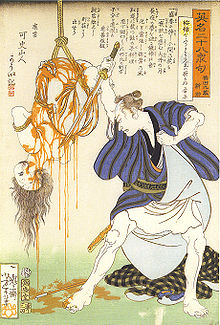- Muzan-e
-
The Muzan-e, also known as the 'Bloody Prints' or the 'Twenty Famous Eight Murders with Verse', is a collection a of Japanese ukiyo-e by artist Yoshitoshi from the 1860s, which depicted several gruesome acts of murder or torture based on historical events or scenes in Kabuki plays.[1] Although most of the works are solely violent by nature, it is perhaps the first known example of ero guro or the erotic grotesque in Japanese culture, an art sub-genre which depicts either erotic or extreme images of violence and mutilation. The Muzan-e has influenced many modern day art formats and ero guro can be found in manga with the works of Suehiro Maruo, Shintaro Kago or Toshio Maeda; in many live action films such as the pink film movement and most of the works of director Takashi Miike and even non-Japanese artists such as Trevor Brown.
Muzan translates from Japanese as cruelty or atrocity,[2] and the works were said to spread a general panic amongst the populace at the time of publishing, with the extreme violence depicted in the paintings taken as a sign of social and moral decline.References to the Muzan-e in other media
- Suehiro Maruo, a manga artist whose works are heavily influenced by the original woodcuts, and artist Kazuichi Hanawa, created a modern version of the Muzan-e in 1988 with an art book entitled Bloody Ukiyo-e. While just as bloody and disturbing as the collection it is based on, Bloody Ukiyo-e also show cases a higher degree of full frontal nudity, sexual perversion and includes pop-culture references and modern real life events, such as painting a gun wielding Marc Bolan as a mercenary or the suicide of Adolf Hitler.
- The Muzan-e is intrinsic to the concluding story arc of the anime series Requiem from the Darkness.
- Muzan-E or Celluloid Nightmares is a 1999 Japanese movie about a female reporter investigating underground snuff tapes.
References
Categories:
Wikimedia Foundation. 2010.

